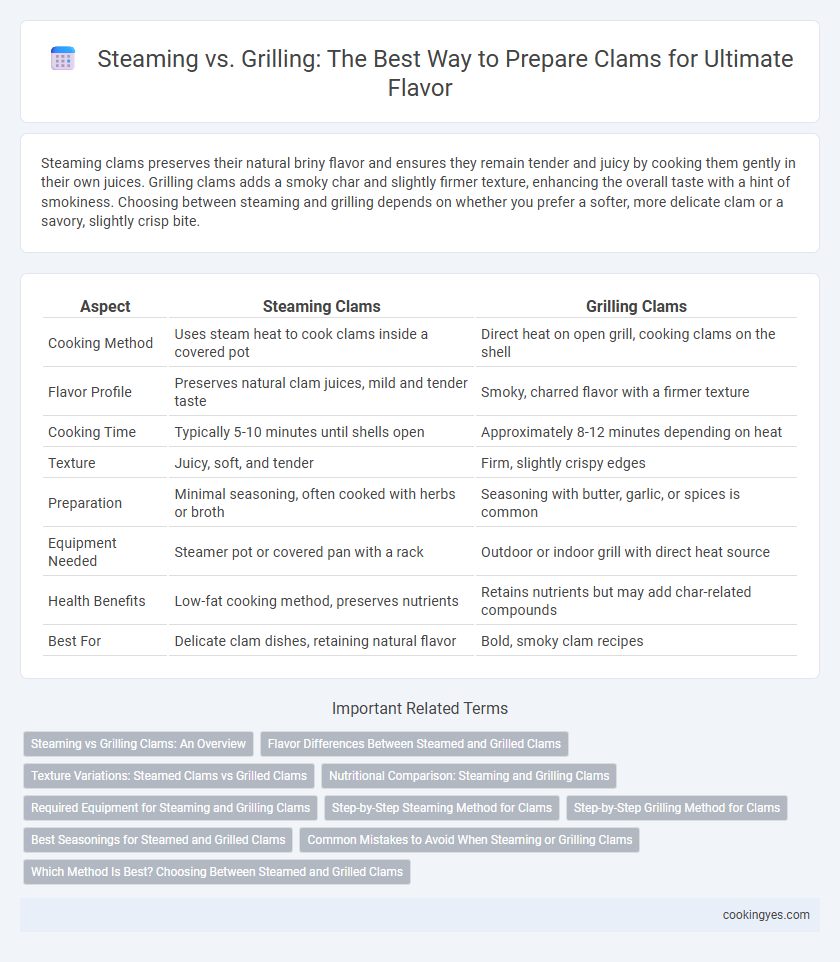Steaming clams preserves their natural briny flavor and ensures they remain tender and juicy by cooking them gently in their own juices. Grilling clams adds a smoky char and slightly firmer texture, enhancing the overall taste with a hint of smokiness. Choosing between steaming and grilling depends on whether you prefer a softer, more delicate clam or a savory, slightly crisp bite.
Table of Comparison
| Aspect | Steaming Clams | Grilling Clams |
|---|---|---|
| Cooking Method | Uses steam heat to cook clams inside a covered pot | Direct heat on open grill, cooking clams on the shell |
| Flavor Profile | Preserves natural clam juices, mild and tender taste | Smoky, charred flavor with a firmer texture |
| Cooking Time | Typically 5-10 minutes until shells open | Approximately 8-12 minutes depending on heat |
| Texture | Juicy, soft, and tender | Firm, slightly crispy edges |
| Preparation | Minimal seasoning, often cooked with herbs or broth | Seasoning with butter, garlic, or spices is common |
| Equipment Needed | Steamer pot or covered pan with a rack | Outdoor or indoor grill with direct heat source |
| Health Benefits | Low-fat cooking method, preserves nutrients | Retains nutrients but may add char-related compounds |
| Best For | Delicate clam dishes, retaining natural flavor | Bold, smoky clam recipes |
Steaming vs Grilling Clams: An Overview
Steaming clams preserves their natural briny flavor and ensures even cooking by surrounding them with moist heat, typically taking 5-10 minutes depending on size, while grilling imparts a smoky taste and slightly charred texture through direct exposure to high heat. Steamed clams retain more moisture and tenderness, making them ideal for dishes requiring juiciness, whereas grilled clams develop a firmer bite and enhanced smoky aroma suited for robust recipes. Both methods are popular in seafood cuisine, but steaming is preferred for delicate clam varieties like littlenecks, while grilling complements larger clams such as quahogs.
Flavor Differences Between Steamed and Grilled Clams
Steamed clams retain their natural briny sweetness and tender texture, absorbing subtle flavors from aromatic herbs and broth, resulting in a delicate, ocean-fresh taste. Grilled clams develop a smoky, charred flavor with a slightly firmer bite, as the heat caramelizes their natural sugars and intensifies their umami notes. Choosing between steaming and grilling clams depends on whether you prefer a lighter, more nuanced flavor profile or a bold, smoky taste infused by direct flame.
Texture Variations: Steamed Clams vs Grilled Clams
Steamed clams retain a tender, juicy texture as the gentle heat preserves moisture within the shell, resulting in a soft bite with a subtly briny flavor. Grilled clams develop a firmer, slightly chewy texture with charred edges that add a smoky depth, enhancing the natural sweetness of the seafood. Texture variations between steaming and grilling stem from cooking methods: steaming locks in moisture, while grilling exposes clams to direct heat, altering their consistency and flavor profile.
Nutritional Comparison: Steaming and Grilling Clams
Steaming clams retains more water-soluble vitamins such as B12 and minerals like zinc, preserving their natural nutrients with minimal fat addition. Grilling clams can enhance flavor through Maillard reactions but may cause slight nutrient loss due to higher heat exposure, particularly reducing vitamin C content. Both methods deliver lean protein, but steaming offers a more nutrient-preserving option compared to grilling.
Required Equipment for Steaming and Grilling Clams
Steaming clams requires a large pot with a tight-fitting lid and a steaming basket or rack to keep the clams elevated above boiling water, ensuring even heat distribution. Grilling clams necessitates a grill with adjustable grates and heat control, as well as sturdy tongs to handle the hot shells safely. Both methods benefit from a brush or cloth to clean the clams before cooking and a heat-resistant surface for resting the cooked clams.
Step-by-Step Steaming Method for Clams
Steaming clams preserves their natural juices and ensures tender, flavorful results by cooking them gently. Begin by thoroughly rinsing the clams to remove sand, then place them in a steamer basket over boiling water, covering tightly to trap steam. Steam the clams for 5-10 minutes until their shells open, discard any unopened clams, and serve immediately to enjoy the optimal texture and sweetness.
Step-by-Step Grilling Method for Clams
Place cleaned clams on a preheated grill over medium-high heat, ensuring the shell side is down to retain juices. Grill for approximately 5-7 minutes until the shells open, indicating that the clams are cooked; discard any that remain closed. Serve immediately with melted butter, lemon wedges, and fresh herbs for enhanced flavor.
Best Seasonings for Steamed and Grilled Clams
Steamed clams pair perfectly with simple seasonings such as garlic, white wine, lemon juice, and fresh parsley, enhancing their natural briny flavor without overpowering it. Grilled clams benefit from bolder seasonings like smoked paprika, chili flakes, and a drizzle of garlic butter or herb-infused olive oil to complement the smoky char and add depth. Both methods highlight fresh clams' unique taste when seasoned thoughtfully, ensuring a deliciously balanced seafood experience.
Common Mistakes to Avoid When Steaming or Grilling Clams
Overcooking clams by steaming or grilling can lead to rubbery, tough textures that diminish flavor and enjoyment. Using excessive heat causes clams to shrink and lose moisture, while failing to clean them thoroughly may result in gritty bites. Avoid sealing clams too tightly during grilling or neglecting to monitor steaming time closely to ensure perfectly cooked, succulent clams every time.
Which Method Is Best? Choosing Between Steamed and Grilled Clams
Steaming clams preserves their natural briny flavor and tender texture by cooking them gently in their own juices, making it ideal for showcasing freshness. Grilling imparts a smoky, charred taste and firmer bite, enhancing the clams' depth with caramelization from direct heat. The best method depends on whether you prefer delicate, pure clam taste (steaming) or bold, smoky flavors with a slightly chewy texture (grilling).
Steaming vs Grilling for clam preparation Infographic

 cookingyes.com
cookingyes.com